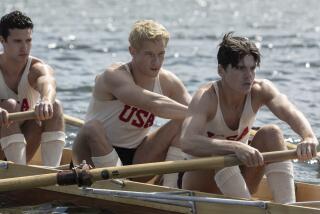Sailboat Race Around the World : Skippers Must Beware of Growlers
- Share via
NEWPORT, R.I. — The talk in Cape Town among the solo-around-the-world sailboat racers was about ice.
Specifically, icebergs. As the 19 boats prepared to resume the race across 6,500 nautical miles of Indian Ocean for Sydney, Australia, the solo skippers were gearing up for an entirely new race.
The first leg was a tactical one, confronting the competitors with options.
This leg will be, for the most part, a wild, downhill sleigh ride. Propelled by strong westerly winds and an east-setting current in the Roaring 40s, some of the boats will log record speeds and 24-hour runs close to 300 nautical miles.
Skippers will fight to keep control as their crafts careen down the faces of precipitous waves. Turning sideways in a broach or cartwheeling in such conditions can cost the sailor his boat and his life.
In the 1982-83 BOC Challenge, Tony Lush lost his boat, Lady Pepperell, 1,500 miles from Cape Town. He was rescued by a nearby competitor.
This time, there’s ice.
The racers have heard reports of icebergs at 45 degrees south latitude--directly in their path to Australia.
The farther south they can safely sail, the shorter the course.
A glance at a south polar projection of the globe shows that a straight line route from Cape Town to Australia would reach 63 degrees latitude, an impossible course because it lies within the Antarctic ice pack.
So the fleet will stay clear of the pack ice. But icebergs are another matter. The problem is knowing where they are.
The Joint Ice Center in Washington is of little help. The center tracks, chiefly by satellite, only bergs that are 15 nautical miles long or longer. That’s more than 17 statute miles.
At the moment, the center is tracking a blue-white block of ice that is more than 50 statute miles long and 34 miles wide that would stretch from well south of Washington, north past Baltimore, obliterating both cities.
This queen of the ice parade is loitering southeast of Cape Horn at 63 degrees. For the moment, it is the northernmost chunk of ice on the Ice Center’s scope.
But for sailboats, big bergs are not the chief ice problem. The big ones alert sailors to their presence by a drop in temperature and by their smell. Veteran navigators in iceberg country report that bergs give off a distinctive odor.
It is the smaller ones that present the greatest risk. Called growlers, they’re as big as a house and float level with the surface. They can only be seen as a slight alteration in the color and texture of the sea ahead--if it’s daylight, if there’s no fog and if the sailor happens to be looking.
A 12-ton boat hitting one of these at eight knots can rip its bottom out and sink before its hapless skipper comprehends what has happened.
Joseph Conrad writes of an experience he had early in the century as an officer on a square rigger shouldering its way through the Southern Ocean in heavy seas and a near gale.
He had gone aloft to direct a sail change. Looking ahead, he spotted the telltale sheen of a deadly growler lying directly in the ship’s path.
He screamed down to the captain and helmsman. Miraculously, he was heard above the roar of the wind. The course was altered and disaster averted.
Conrad commented that the incident gave him a vivid insight into the meaning of the grim notices that were too frequently posted in London shipping circles: “Overdue. Presumed lost.” That would be all that would ever be known of a ship, a cargo and the fate of 40 men.
And so the talk among the BOC Challengers before they set sail from Cape Town Saturday was about ice. What they probably didn’t talk about was their private speculation about how many boats will not arrive at Sydney, the halfway point in this race around the world.
So far, 4 of 25 starters are officially out. Besides Airforce, which sank, America’s Quailo, Japan’s Madonna and Brazil’s Miss Global have officially withdrawn.
Two boats still in the race were not in Cape Town in time for the restart--Australia’s ACI Crusader and New Zealand’s Neptune’s Express.
Dick McBride, 43 days after he was dismasted at the Equator and 36 days after arriving at Recife, Brazil, for what he hoped would be a quick mast replacement, finally got under way last week.
At midweek, he was 2,300 miles from Cape Town, and about 500 miles behind John Biddlecombe aboard ACI Crusader. The boats, both fast 60 footers, will have their own match race to Sydney.
And McBride will have company on board--a parrot called Recife.
More to Read
Sign up for The Wild
We’ll help you find the best places to hike, bike and run, as well as the perfect silent spots for meditation and yoga.
You may occasionally receive promotional content from the Los Angeles Times.






